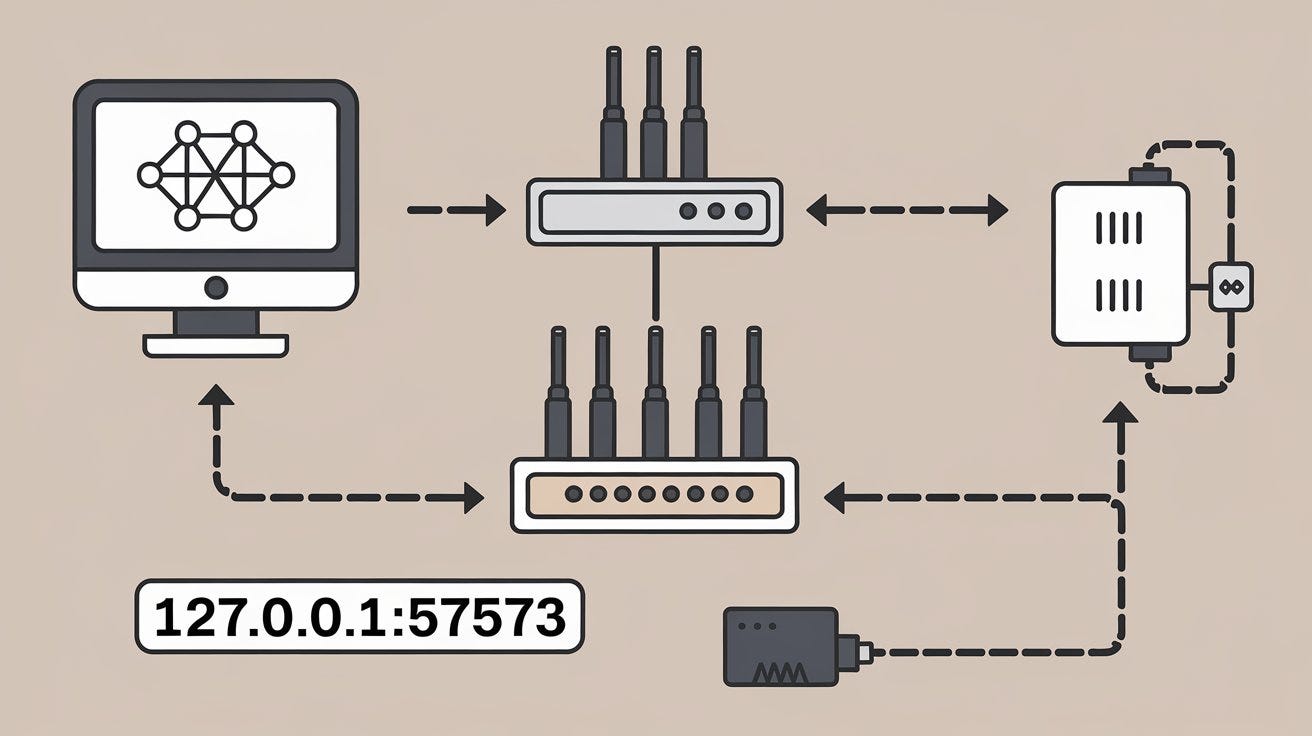Understanding the Localhost Address: A Deep Dive into 127.0.0.1:57573

Introduction to Localhost and IP Addresses
The concept of “localhost” and its associated IP address, 127.0.0.1:57573, is fundamental in networking, particularly in web development and software engineering. Localhost refers to the local computer that a person is currently using. When you type 127.0.0.1:57573 into a web browser, you’re directing it to access resources on your machine rather than searching the web. The address 127.0.0.1:57573 is the loopback address, allowing developers and users to test applications and services locally before deploying them to a live environment.
In technical terms, the Internet Protocol (IP) is a set of rules governing the data format sent over the Internet or local network. IP addresses are numerical labels assigned to devices in a computer network that uses the Internet Protocol for communication. These addresses serve two main functions: identifying the host or network interface and providing the device’s location in the network. 127.0.0.1:57573, part of the IPv4 range, is often associated with various applications, especially in development and testing.
The Importance of Port Numbers: What is 127.0.0.1:57573?
Understanding Port Numbers 127.0.0.1:57573
When discussing IP addresses, the conversation typically extends to port numbers, which are crucial in facilitating communication between devices on a network. A port number is a numerical label from 0 to 65535 that identifies a specific process or service on a computer. When data is transmitted over the Internet, it’s sent to a particular IP address and port number combination, allowing multiple applications to run simultaneously without interference.

In this case, port number 127.0.0.1:57573 signifies a particular service or application listening for requests on the localhost address. While many well-known port numbers are reserved for specific protocols (like HTTP on port 80 or HTTPS on port 443), custom applications can use any port number, including 57573.
Why Port 127.0.0.1:57573 ?
So, why 57573? The choice of port numbers can often seem arbitrary, especially in local development environments. Developers usually select port numbers not currently used by other applications to avoid conflicts. Port 57573 might have been chosen simply because it was available and not commonly associated with well-known services. Using high-numbered ports (above 49152) is typical for dynamic or private use, making it leit’sikely to interfere with standard applications.
Practical Applications of 127.0.0.1:57573
When you access 127.0.0.1:57573 in your web browser, you typically connect to a syou’reervice running on your local machine. This might be a web server, database management interface, or any other application requiring network connectivity. For instance, web developers often run local servers to test their applications before making them public.
This could commonly be a Node.js application, a Python Flask server, or any web framework you might be using. Accessing the service via this address allows for real-time interaction without needing an Internet connection, making development faster and more efficient.
Setting Up a Local Development Environment
The Basics of Local Development
Creating a local development environment is crucial for software developers, allowing them to test their applications in a controlled setting. The localhost server runs on your machine and can be accessed through the IP address 127.0.0.1:57573 and a specific port number, like 57573.
Developers often use tools like XAMPP, WAMP, or built-in servers provided by programming languages and frameworks to set up a local server. These tools simplify the server running process and can be configured to serve web pages or APIs from the local file system.
Installing Necessary Software
- Choose a Web Server: Depending on your development needs, you might select a lightweight server like Apache or Nginx, or you might choose to run a development server provided by a framework, such as Flask for Python or Express for Node.js.
- Install the Server: To set up a Node.js server, you would first need to install Node.js on your machine. Once installed, you can create and run a simple server script, which will listen on your chosen port, such as 57573.
- Configure Your Environment: After installing the necessary software, you must configyou’llure your environment. This could involve setting environment variables, defining configuration files, and ensuring your application listens to the desired port.
Testing Your Setup
Once your local server is up and running, testing it is straightforward. Open your web browser and navigate to 127.0.0.1:57573. You should see the application or service you’ve you’veed if everything is configured correctly. This local testing is invaluable for identifying issues before pushing code to a production environment.
Troubleshooting Common Issues
Connection Issues
One of the most common issues developers encounter when accessing 127.0.0.1:57573 is connection problems. If the server isn’t risn’tg or is misconfigured, you’ll you’ll receive an error message indicating that the connection has been refused. Here are a few troubleshooting steps to consider:
- Check Server Status: Ensure your local server is actively running and listening on the correct port. You can often verify this in your terminal or command prompt.
- Firewall Settings: Sometimes, firewall settings can block access to specific ports. Ensure that your firewall allows connections on port 127.0.0.1:57573.
- Correct URL: Double-check the URL you’re you’re to access. Ensure there are no typos in the address or port number.
Application Errors
If the server is running but you’re you’retering application errors, it could be due to issues within the code itself. Common problems include:
- Syntax Errors: Check your code for any syntax errors that could prevent the application from running correctly.
- Dependency Issues: Ensure that all necessary dependencies are installed. A missing library or package could lead to runtime errors.
- Configuration Files: Review your configuration files for incorrect settings, such as database connections or environment variables.
Logs and Debugging
Most web frameworks and servers have logging capabilities to help you identify issues. Check the server logs for error messages that could provide insight into what’s what’swrong. Additionally, using debugging tools and techniques, such as breakpoints or print statements, can help trace the flow of execution in your application.
Security Considerations for Local Development
Understanding Local Security Risks
While developing locally, it’s 127.0.0.1:57573 overlook security considerations, but it’s esit’sial to recognize that local environments can still pose risks. An open port on your local machine can potentially be accessed by unauthorized users, especially if your machine is connected to a public network.
Best Practices for Securing Your Local Server
- Use Firewalls: Ensure your operating system’system’sll is enabled and properly configured to block unwanted access to your local server.
- Limit Network Access: Configure your local server only to accept connections from localhost (127.0.0.1:57573) and block access from external IP addresses.
- Secure Sensitive Data: Avoid hardcoding sensitive information like API keys or passwords in your code. Use environment variables to keep this data secure.
Testing Security in Local Environments
While your local environment may not be exposed to the internet, testing for security vulnerabilities is still a good practice. Utilize tools like OWASP ZAP or Burp Suite to identify potential security issues in your applications. This proactive approach will prepare you for the security challenges you may face in a production environment.
Deploying Your Application: Moving from Local to Production
Preparing for Deployment
The next step is deployment once you’ve you’veped and tested your application locally. This involves transferring your application from your local environment to a production server. Before doing so, you must preparit’se your application to ensure a smooth transition.
- Code Cleanup: Review your code and remove debug statements or unused code. Ensure that only necessary files are included in the deployment.
- Configuration Changes: Update configuration files to match the production environment, such as database connection strings, API keys, and environment-specific settings.
- Testing in Staging: If possible, deploy your application to a staging environment that mimics production. This step allows you to catch any issues before going live.
Choosing a Hosting Provider
Selecting the right hosting provider is crucial for your 127.0.0.1:57573. When making your decision, consider factors such as scalability, reliability, support, and cost. Popular options include shared hosting, virtual private servers (127.0.0.1:57573), or cloud-based solutions like AWS or Heroku.
Monitoring Post-Deployment
After deployment, monitoring your ait’spplication for performance and security is essential. Tools like Google Analytics, New Relic, or LogRocket can help track user interactions, application performance, and potential errors. Staying vigilant post-deployment ensures you can quickly address any issues in a live environment.
Conclusion
Understanding and utilizing the IP address 127.0.0.1:57573 is crucial for developers working in local environments. From setting up your development environment to troubleshooting and securing your applications, a solid grasp of localhost and port numbers will enhance your development workflow.
The journey from local development to 127.0.0.1:57573is filled with learning opportunities. By adhering to best practices and remaining proactive in testing and security, developers can create robust applications ready for production challenges.





